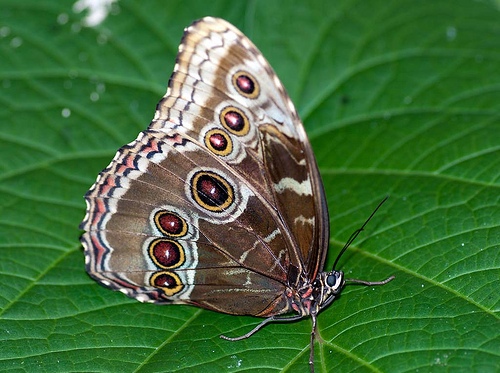
Opsiphanes tamarindi(Opsiphanes tamarindi)
Phylum —arthropoda
Class —insecta
Order — lepidoptera
Family —nymphalidae
Genus –opsiphanes
Appearance
The caterpillars are green, with a lighter stripe on the back, a shield with 8 horns on the head, and two small tails at the end of the body. The wingspan of this butterfly is 90-100 mm. The wings are coffee-colored with a broad horizontal light yellow stripe on the forewings. The underparts are beige-brown with several large eyes.
Habitat
Opsiphanes tamarindi occurs from Mexico to Bolivia.
Behavior
Opsiphanes tamarindi is crepuscular in behavior, flying mainly between 17:00 hrs and nightfall. It is active again between dawn and about 10:30 hrs, at which time it visits rotting fruit including banana bait. Males also visit urine-tainted ground for minerals. The butterflies are sedentary in behavior, and usually so engrossed in feeding that they are very reluctant to move.
Diet
The caterpillars feed on the leaves of banana plants.Adults feed on rotting fruit.
Reproduction
For their reproduction you need a terrarium with a size of 50 x 50 x 70 cm. Females lay eggs one or more at a time on the stems and underside of the leaves of the forage plant. The eggs are spherical, pearly white. The incubation period is 12 days.It is better to keep the caterpillars in terrariums for 6-8 insects, placing a pot with a forage plant in it. At the bottom, you can lay a paper towel, which must be replaced daily.
The temperature is 22-25oC. The humidity is 65-75%. The caterpillar develops for more than 2 months. Pupae are green or brown. The pupal stage lasts approximately for 22 days. Butterflies live for 2-3 weeks.
In captivity
The mesh terrarium with a size of 50 × 50 × 70 mm is suitable for keeping butterflies. Room temperature is necessary. Daylight time is 12 hours. You can feed butterflies an overripe banana or with honey syrup diluted with boiled water in a ratio of 1:10.
 Russian
Russian
 English
English























